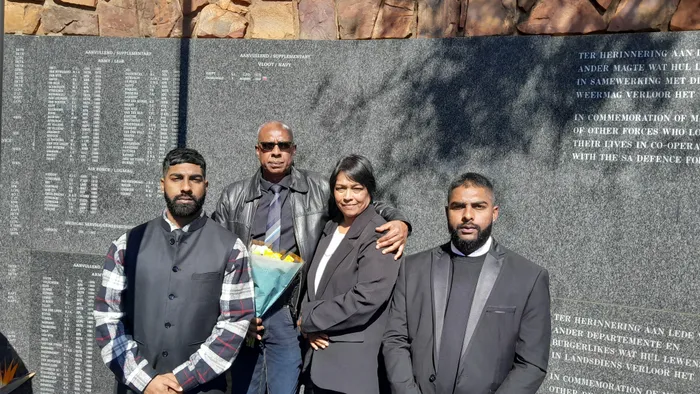Honouring seaman Pooventharan Thangavalu: a tribute on the Wall of Remembrance
ACKNOWLEDGEMENT

Seaman Pooventharan Thangavalu of the South African Marine Corps, who was killed in 1989.
Image: Supplied
IT was a bitter-sweet moment for the family of the late Seaman Pooventharan Thangavalu of the then-South African Marine Corps, whose name was recently added to the Wall of Remembrance.
The wall, which is situated at the Voortrekker Monument in Pretoria, carries the names of those that served in the South African military and died during the Angolan bush war.
Thangavalu, who hailed from Merebank, was shot and killed by a fellow marine on January 23 in 1989. He was 19-years-old at the time.
Perseelan Thangavalu, his elder brother, said the family were left feeling overwhelmed with his acknowledgement.

Thangavalu’s family members, from left, Chance Thangavalu (nephew), Perseelan Thangavalu (brother), Prabashinie Thangavalu (sister-in-law), and Lance Thangavalu (nephew), in front of the Wall of Remembrance where his name was included.
Image: Supplied
“We feel a deep sense of pride and honour that my brother has been acknowledged for his service. Although it has been over 30 years since his passing, our family, especially our mother, still feels the pain of our loss. But it has definitely brought us some joy to see his name on the wall, alongside the others who are part of our country’s military history,” he said.
Vinesh Selvan, public relations officer for the South African Indian Legion (SAIL) of Military Veterans, said he was contacted by a member of the Pro Patria Museum requesting the names of fallen Indian participants during the war.
“The only Indian whose name reflected on the wall was that of Airman P Ramsamy, who was a fireman in the Air Force. The only other member to my knowledge was Thangavalu.”
Selvan said Thangavalu was killed instantly in a shooting incident while stationed at Wenela Military Base in Namibia.
“Earlier in the day, a fellow marine had entered the bungalow and removed the magazine from his rifle without carrying out safety checks to ensure the rifle chamber was clear. He put the rifle down on his bed and went off on an exercise run.
“The same marine, together with Thangavalu later returned to the bungalow. The marine picked up the weapon and they both proceeded to joke around and play games with it. Despite calls from fellow marines to desist, the two of them continued to joke and play around with the rifle until a shot went off, hitting Thangavalu in the head and killing him instantly,” he said.
Selvan said the addition of Thangavalu’s name to the wall signified an acknowledgment of the Indian participation in the Angolan bush war.
“During the Angolan bush war, the marines were tasked to perform patrols with their boats along the rivers, as well as border patrols to prevent enemy fighters from entering South West Africa and attacking the South African forces. His name and sacrifice have not been forgotten.”
Selvan added that among the non-profit organisation’s projects included erecting a Wall of Remembrance at the Castle of Good Hope in Cape Town and one in Durban.
“We are still looking for a site in Durban. The Indian military history in South Africa is almost non-existent in military museums, and SAIL is busy writing the story of Indians into history and into museums.We have completed the Indian military history in the South African Air Force Museum, which has three locations - Pretoria, Port Elizabeth, and Cape Town.
“We have also erected a Wall of Remembrance and recently completed the ‘Role of Indians in the South African Military’ exhibition at the Ditsong National Museum of Military History in Johannesburg. In October, we will also be hosting our annual commemorative service in Johannesburg and Durban to remember the fallen Indian soldiers of South Africa,” he said.